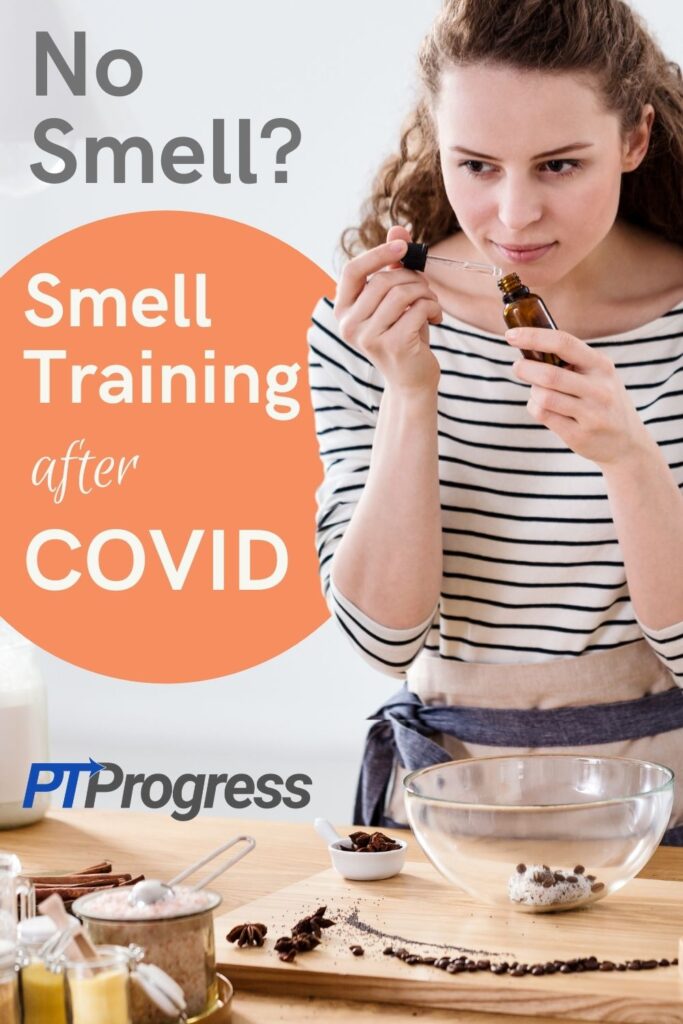
Ever heard of “smell training”? Well, you’ve probably heard of the bizarre yet common Covid19 symptom called anosmia, or coronavirus loss of taste and smell. You can recover this loss through smell therapy – without having to see a physical therapist!
Smell Training: A Side Quest of Covid19 Recovery
The journey to recovery from Covid19 is a long one for many of us. I know; I got it this winter. As my recovery neared its completion, I found myself on a side quest to get back my sense of smell that “Rona” stole from me.
A full 17 days after I started showing Covid19 symptoms, I felt good. I had no lingering symptoms, except for the pesky anosmia. After all that time resting and quarantining, my smell and taste hadn’t fully returned, although it was miles better than when I was at the peak of my infection.
Holding onto my hope for a full recovery, I stumbled upon some interesting research that helped me regain my sense of smell. It’s called olfactory training (or smell training) and is like physical therapy for your nose. Of course, as a Physical Therapist, I was intrigued by this training and had to try it out for myself.
Drawing on this research, I devised a smell therapy technique which I’d like to share with you. Conveniently, smell training is simple enough to do on your own at home.
Smell Therapy Research Findings
If you’ve lost your sense of smell recently because of the coronavirus, I understand how you’re feeling. It’s discouraging, and at times depressing, to be unable to smell or taste anything. You may feel you’ve lost hope in getting these senses back.
But after diving into a lot of the research, I’ve learned a couple of things:
- Most people recover their senses of smell and taste within 2–3 weeks after a viral infection.
- For those with a longer recovery, olfactory training expedited results, improving sense of smell after about 12-16 weeks.
Now, 12-16 weeks may seem like a long time to get results. But such an extended recovery is uncommon; most cases of anosmia resolve within 3 weeks of a viral infection like Covid19. And personally, by week 3 I started to notice positive changes in my ability to smell and taste food – an encouragement which only bolstered my efforts in smell therapy.
I noticed an odd correlation between the time of day and my anosmia. For instance, my sense of smell felt weaker in the morning; I was unable to smell coffee beans early in the day, but after smell training, I was able to pick up the scent of coffee beans by the afternoon. You, too, may notice some fluctuations in your anosmia throughout the day.
Of course, everyone is different. This isn’t medical advice, and I’m not your physical therapist; consult your doctor if you continue to experience anosmia for months after contracting Covid19.
Let’s dive into the smell training.
4 Scents to Use in Smell Training
Based on the most commonly cited study by Dr. Thomas Hummel, olfactory training uses 4 unique scents to cover 4 fragrance categories:
| Example Scent | Fragrance Category |
| Lemon | Fruit |
| Rose | Floral |
| Cloves | Spicy/Bitter |
| Eucalyptus | Resinous (like fresh cleaning solution) |
These categories come from an early 1900s categorization of fragrance types, illustrated by this prism. As you can see, the original categorization included two additional types: putrid and burnt fragrances. These scents are difficult and, frankly, undesirable to store, and therefore not part of olfactory training. But by using the other 4 fragrance categories – fruity, flowery, spicy, and resinous – you’ll still achieve a robust smell therapy experience.
To perform olfactory training, you’ll need to collect four jars of scents. Essential oils will do the trick, and they are easy to buy on Amazon for about $5.
But the scents don’t have to be essential oils; and honestly, I’m not sure they have to be the exact scents I listed. I haven’t read anything to suggest that you shouldn’t use other scents like coffee beans, peanut butter, or your favorite cologne or perfume. I incorporated these other scents into my routine and found their familiarity was useful to my olfactory training. Smells that are meaningful and easily-recognizable make the best smell therapy aids.
If you use essential oils, you could conduct your smell training straight out of the bottles. However, many experts recommend transferring each scent into a separate container. You would do this by applying 5-6 drops of the oil onto a piece of absorbent paper (such as watercolor paper) and placing each scent into an amber glass jar. A dark jar, as opposed to a clear jar, will keep out any light and better preserve the smell.
Easy Smell Training Exercise
Now here’s the exercise: Remove the cap on your jar and smell the fragrance for about 10 to 15 seconds. Repeat this exercise twice each day. Taking several small sniffs, try to keep the smell at the top of your nasal cavity; don’t just take a giant whiff of the jar.
As you smell, think about the fragrance. Envision cutting up a lemon or smelling a bouquet of flowers or waking up to your favorite cup of coffee. Whatever scent you’re smelling (or not smelling) at the time, try to be very mindful, imagining its sensation.
You may feel silly imagining these scents, but remember: smell happens in the brain. Once each fragrance enters your nasal cavity, it is processed as a nerve signal and transmitted through the olfactory bulb into the identifying parts of the brain. Research suspects that damage to this connection between the nasal cavity and the brain is what causes post-viral anosmia. The sense of smell is recovered by repairing these neural connections in the brain through neuroplasticity.
Tracking Your Smell Therapy Progress
Here’s a rehash of your smell therapy objectives:
- Establish a routine of smelling these 4 jars twice every day
- Sniff each jar for 10-15 seconds
- Concentrate on each smell and imagine the scent
Finally, your smell therapy wouldn’t be complete without – you guessed it – paperwork. In order to track your progress, you need to log your results!
While it may be difficult to quantify how much your smell or taste improves each day, you should still keep track of each time you go through the scents, making notes wherever possible.
I found it helpful to note scents as I started to recognize them, so jot down whenever you pick up on hints of your favorite perfume or tastes from a meal or beverage. Make a chart, and fill it out as much as possible to get a sense of your scents.
If you’re like me, you may start to notice patterns, such as having a weaker sense of smell in the morning, or experience changes in day-to-day smells such as coffee beans.
Keep working on those familiar smells even if they don’t seem to smell the same as they did before. It may take a few weeks for the olfactory pathway to fully recover.
It May Be a Long Road to Recovery
Most patients recover their sense of taste and smell within 3 weeks, with 7 days as the median recovery interval. However, according to a recent report, patients 20–39 years old tend to experience a longer recovery time.
Nevertheless, don’t lose hope. Most people recover their sense of smell after a viral infection like Covid19, though your recovery time might vary from “the norm.”
If you’re having difficulty regaining your smell or want to try actively rehabilitating it, consider olfactory training. All you have to do is gather a few of the scents I mentioned, store them in a convenient place, and practice smelling them for 10-15 seconds at least twice a day. If you track your progress, you might be encouraged to see your sense of smell gradually gain new strength.
Final thoughts: Just like in physical therapy, smell recovery doesn’t happen overnight. Be patient, and let me know in a comment below how your sense of smell and taste are coming along.


It’s been 4 months since I’ve had Covid and my sense of smell isn’t back fully. I tried the smell training in the beginning seem to work and even went to an acupuncturist to help as well but I’m still limited to what I can smell.. do u think doing this smell training again will help?